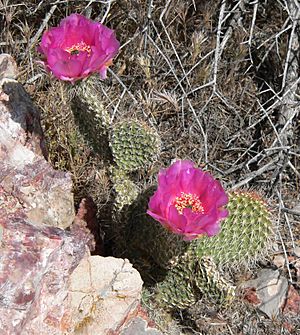Plains pricklypear facts for kids
Quick facts for kids Plains pricklypear |
|
|---|---|
 |
|
| Conservation status | |
| Scientific classification | |
| Genus: |
Opuntia
|
| Species: |
polyacantha
|
Opuntia polyacantha is a common type of cactus that grows in North America. People call it by several names, like plains pricklypear or starvation pricklypear. You can find it across Western Canada, the Great Plains, and parts of the central and Western United States, as well as Chihuahua in northern Mexico. This tough cactus grows in many different places, from sagebrush areas to Ponderosa pine forests, prairies, and shrublands.
Contents
What is the Plains Pricklypear Like?
Opuntia polyacantha usually grows about 4–12 in (100–300 mm) tall. It spreads out, forming flat mats of pads that can be 2–3 m (6+1⁄2–9+7⁄8 ft) wide. Its green, juicy pads are oval or round. They can be as big as 27 by 18 cm (10+5⁄8 by 7+1⁄8 in).
Spines and Flowers
The cactus pads have small bumps called areoles. These areoles have fuzzy brown fibers and tiny, barbed bristles called glochids. Many areoles also have sharp spines. These spines can be very different in size and shape. They might be 0.4 to 18.5 cm (1⁄8 to 7+1⁄4 in) long, thick or thin, straight or curly. They also come in many colors.
The flowers are 2.5 to 4 cm (1 to 1+5⁄8 in) long. They can be yellow or a bright magenta color. After the flowers, the cactus grows a dry, spiny, brownish fruit.
How it Reproduces
This cactus can make new plants in a few ways. It can grow from seeds. It can also grow from layering, which means new roots form from a stem that touches the ground. If a piece of the cactus breaks off, it can even grow into a new plant.
Where it Lives
This cactus is very strong. It can live in places with huge temperature changes. It survives very cold winters, down to −46 °C (−50 °F), in places like the Yukon Territory in Canada. It also survives very hot summers, well above 38 °C (100 °F), in places like Chihuahua, Mexico. Because it grows in so many different places, there are many slightly different types of O. polyacantha.
How People and Animals Use It
Native Americans used this cactus as a medicinal plant. Different parts of the plant helped treat various health problems.
Food for Animals
The plains pricklypear is an important food source for many animals. For example, it makes up more than half of the winter food for black-tailed prairie dogs in some areas. Pronghorn antelope also eat it, especially after wildfires burn off the sharp spines.
Ranchers sometimes burn patches of the cactus on purpose. This makes it easier for their livestock (like cows) to eat it when there isn't much other food around. This cactus can also grow in poor soil where other plants won't grow well. If you see a lot of this cactus, it often means the land isn't very good for farming.
Insects and Explorers
Some insects like to eat this cactus. These include the cactus moth Melitara dentata and the cactus bug Chelinidea vittiger.
The famous Lewis and Clark Expedition explorers saw this plant often. Sometimes they admired it, but more often they complained about its sharp spines!
Eating the Fruit
You can eat the fruit of the O. polyacantha. First, you need to remove the skin and the seeds. Then, you can eat it raw or even make it into candy.
See also
 In Spanish: Opuntia polyacantha para niños
In Spanish: Opuntia polyacantha para niños


